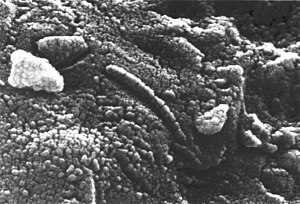 Back when I was hosting Inside Space, this was one of my most interesting shoots. I took a day off from work in Connecticut, hopped a Continental flight to Houston and headed to NASA in Clear Lake. Instead of the usual visit to see ‘manned spaceflight’ experts (NASA JSC’s expertise), we went to see Dr. David McKay in his well equipped laboratory.
Back when I was hosting Inside Space, this was one of my most interesting shoots. I took a day off from work in Connecticut, hopped a Continental flight to Houston and headed to NASA in Clear Lake. Instead of the usual visit to see ‘manned spaceflight’ experts (NASA JSC’s expertise), we went to see Dr. David McKay in his well equipped laboratory.
There, hidden inside a ‘glove box’ was ALH84001 – a Martian meteorite found in the Allan Hills of Antarctica.
Because part of the ice sheet in the hills melts back every year, and the ground has been scraped clean over the millennial, any rock found must have come from outer space. Scientists just pick them up from the round, as if they were picking berries.
That afternoon in Houston, I got to stick my hand into the gloves and picked up a sample. It was pretty heady stuff, especially since Dr. McKay thought this meteorite contained telltale signs of life on Mars!
There’s an AP story today, and the conventional wisdom isn’t quite as positive as it was then.
I feel bad for McKay, who was a genuinely nice guy and obviously dedicated scientist. But that’s not the reason I’m writing this.
On that day in Houston, I discovered when scientists talk about life on distant planets, they’re using a different definition of life than you or I might use. Even if McKay had been totally right about what was inside ALH84001, to me his discovery was more chemistry than life, and I said that to him there in Houston (not that my personal opinion was at all important to the greater scientific community).
When I think of life, I think of something more complex than what was thought to be in the meteorite. The idea was, ALH84001 had “fossils of ancient Martian microbes, or maybe traces of them, preserved in the cracks and pore spaces.”
From Wikipedia:
I was very disappointed. When I heard life, I wanted something more substantial. Maybe some day, but not this day.
I was back home in Connecticut later that same evening.